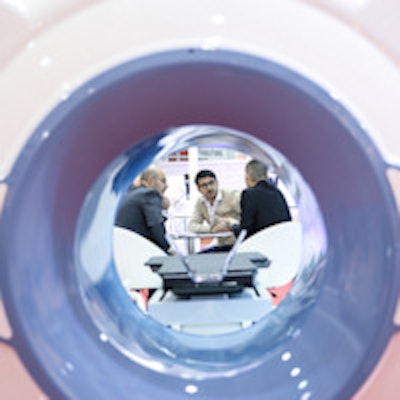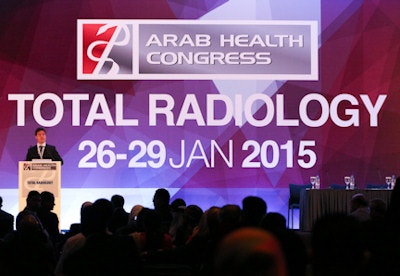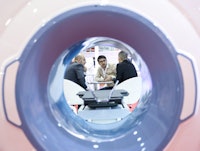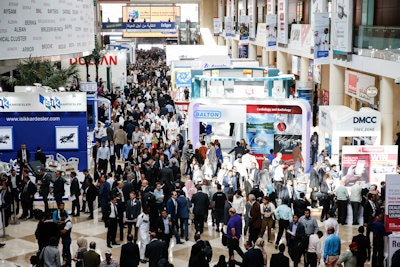
As medical imaging continues to thrive throughout large parts of the Middle East, the radiological community is gearing up for Arab Health 2016, at which intervention, radiation protection, and pediatrics look set to dominate the agenda. European speakers also will play a critical part.
Increasing healthcare expenditure in the United Arab Emirates (UAE) means that emphasis is now shifting toward providing patients with access to state-of-the-art interventional radiology equipment. The recently installed biplane interventional x-ray system at the Cleveland Clinic-run Sheikh Khalifa Medical City in Abu Dhabi is just one example, while the new Gulf Medical University Hospital in Ajman will be the first hospital in the Northern Emirates to have a radiology department with PET/CT -- a step in the right direction for a region working hard to provide universal healthcare coverage for its citizens.
 Total Radiology is the largest single conference held at the annual Arab Health show in Dubai.
Total Radiology is the largest single conference held at the annual Arab Health show in Dubai."As both private and public sector healthcare facilities in the UAE are adapting to the use of increasingly advanced imaging equipment, radiologists across the country will be looking forward to the return of the Total Radiology conference for the opportunity to learn about the latest developments in CT and MRI usage," said Dr. Mohamed Abdel Nabi, head of radiology at the UAE Ministry of Health, and the local chair of the annual Total Radiology meeting at Arab Health, to be held in Dubai, UAE, from 25-28 January.
Total Radiology will host more than 1,000 delegates and aims to examine the latest advances in medical imaging, accurate imaging diagnosis, and improvement of care quality for radiology patients. Previously known as the Imaging and Diagnostics Conference, the 15th Total Radiology forms a vital part of the annual Arab Health Congress, the world's largest continuing medical education (CME)-accredited multitrack medical congress. Arab Health's role in the development of the UAE's healthcare infrastructure is evident as it gears up to welcome more than 130,000 healthcare trade professionals for the 41st time to the exhibition and parallel scientific congress.
Radiation protection in the UAE
A top priority right now in the region is the reduction of radiation dose to the general population from medical exposure, according to Dr. Anthony Bedson, manager of radiology at the Clinical Imaging Institute at Al Ain Hospital, UAE, who will be a moderator and speaker at Total Radiology 2016. The government has established an Emirati Radiation Protection program, along with the Federal Authority for Nuclear Regulation and International Atomic Energy Agency. This 10-year initiative is aimed at reducing unnecessary use of ionizing radiation.
A new introduction at Total Radiology is pediatric and infant sessions (25 January), covering the implementation for radiation protection, imaging of pediatric abdominal masses and acute abdomen, and a systemic approach for bone dysplasia.
"As the discussion surrounding appropriate radiation dose reduction for infants continues to dominate the field, radiologists in the region will get the chance to debate the issue with their peers at this new subsession dedicated to pediatric imaging," Nabi remarked.
 More than 4,000 exhibitors are expected at Arab Health 2016.
More than 4,000 exhibitors are expected at Arab Health 2016.This year's conference will also have a distinctly local feel, given the number of lectures from home-trained radiologists looking to share their experiences with their regional and international counterparts. Key talks include lessons learned from the breast cancer screening program in Saudi Arabia, patient radiation safety from the perspective for the Dubai Heath Authority, and a look at the UAE's experience of MRI for the measurement of iron overload in thalassemia, a genetic disease specific to the region.
"Total Radiology is the perfect platform to encourage local doctors to present their paperwork to a global audience," Nabi said. "This year the conference welcomes more than 50 speakers from around the world, including 25 speakers from the UAE."
The appeal of the conference is that it caters to a mix of disciplines from the radiological faculty including radiologists, technicians, sonographers, internists, and oncologists as well as surgeons and general practitioners. The main aim of the program is to update all the staff working in imaging departments with the recent advances in diagnosis and treatment and to offer an opportunity to gain valuable CME credit hours, which allows them to renew their yearly medical license, he added.
Special challenges for sonographers
Training of sonographers cannot be done quickly, and so the region's hospitals have had to find ways to cover this, Bedson noted. Traditionally, cross-training of staff was carried out on site, but now this issue has been addressed by colleges, universities, and private schools offering ultrasound courses at master's level. These courses are run in conjunction with established courses organized in other countries, so international standards are maintained. For instance, Fatima College of Health Science in Abu Dhabi has established a radiography course in partnership with Monash University in Melbourne, Australia, which will address the issue over the long term once students graduate.
For workers coming from other countries, there is a very stringent vetting procedure, with a primary source verification company checking all qualifications before the health authorities will issue a license. No healthcare professional can work in the UAE without this license. This is an essential process, but again adds time onto the recruitment of staff.
 Over 130,000 healthcare professionals are due to attend the 41st edition of Arab Health in late January.
Over 130,000 healthcare professionals are due to attend the 41st edition of Arab Health in late January.The keynote presentation at Total Radiology will be delivered by Dr. Christian Herold, chairman of the department of biomedical imaging and image-guided therapy at the Medical University of Vienna, who will discuss the evaluation and management of focal pulmonary lesions (25 January). Other lectures include an enterprise imaging strategy on managing clinical imaging content (28 January) and the identification of primary disease processes of the chest and respiratory, gastrointestinal, cardiovascular, and central nervous systems (26-27 January).
Another highly anticipated session takes place on 26 January, when delegates will get a chance to hear presentations approved by the European Society of Radiology on computer-aided detection (CAD), FDG-PET/CT in lung cancer care, and MRI of prostate cancer.
Attendees also get the opportunity to visit the exhibition halls to explore the imaging-related devices and technologies on display from more than 4,000 exhibiting companies. Nabi is confident that combining the scientific sessions with hands-on experience of the latest equipment ensures this is one of the most anticipated meetings on the global radiology calendar.


















